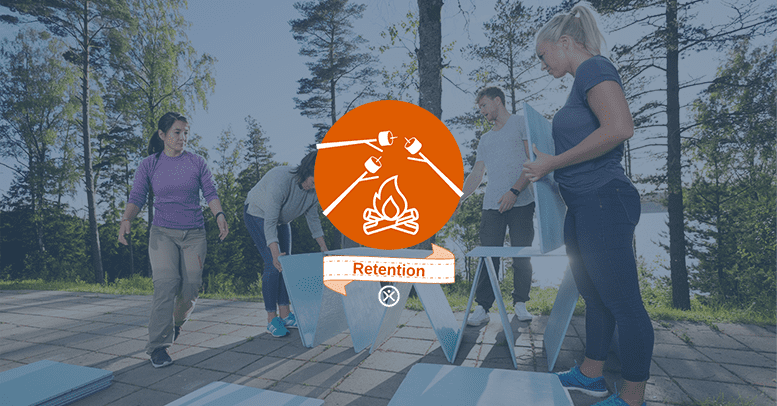For many companies, hiring cools off as the temperature heats up. That’s because your potential new employees probably aren’t thinking about a career move. They’re too busy going on vacation, shuttling kids to camp, perfecting their landscaping, and spending time with loved ones. But, this recruiting slowdown is an ideal opportunity to focus on improving the employment experience for your existing team members. Employee engagement and retention are vital to any organization’s success, so we should never let retention activities cool off. At this year’s employer summer camp, we’ll show you how to earn your retention merit badge.
What is Employee Retention, and Why Does it Matter?
Before we create a strategy to improve employee retention, let’s define the term. Simply put, employee retention is keeping the team members you’ve already hired within your organization. The opposite of employee retention is employee turnover, which is the measure of how many team members leave your firm. Maintaining a stable base of talent is critical for the prosperity and longevity of your company. Let’s take a look at the benefits of strong employee retention and the consequences of weak employee retention.
Benefits of Strong Employee Retention
When the majority of your workers stay, your company enjoys:
- lower recruiting costs (not hiring as often)
- lower training costs (not onboarding or providing initial training as often)
- higher productivity (fewer vacancies mean more work gets done)
- higher morale (employment experience is stable and satisfying)
- better team cohesion (everyone in the group knows each other well)
Unfortunately, the reverse is true when your company’s employee retention rate is low.
Consequences of Weak Employee Retention
When a large percentage of your staff leaves, your organization suffers:
- higher recruiting expenses (hiring often)
- higher training costs (regularly onboarding and training new hires)
- lower productivity (gaps in personnel cause work delays)
- lower morale (employment experience is unstable and unfulfilling)
- poor team cohesion (group members don’t have the chance to form bonds)
As you can see, strong employee retention creates powerful teams that get things done – and saves your company money. Conversely, weak employee retention results in fragmented teams that struggle to keep pace – and negatively impacts your bottom line.
What is a Retention Plan, and How Do You Create One?
So, how do you ensure that your firm doesn’t experience the destructive effects of weak employee retention? You create an employee retention plan, which is a system designed to keep workers engaged with your company long-term. To make your plan, you must understand what your workers need, identify ways to support those needs, and allocate resources for doing so.
Here’s what your team members are looking to your company to provide:
- leaders that are transparent, caring, available, motivating, good under pressure, and reliable
- work-life balance through flexible schedules and telecommuting
- an opportunity to grow professionally and achieve success in their careers
- competitive salary and benefits
- a safe, welcoming work environment
- the chance to work for a company with an honorable mission that believes in environmental and social responsibility
- a tie between their work and the company’s performance and goals
To meet those needs, your company should:
- thoroughly train leaders and provide them with continuous, 360-degree feedback (All-star individual contributors don’t become great managers overnight!)
- allow employees to work remotely on flexible schedules whenever possible
- offer professional development opportunities like training, mentorship, job shadowing, etc.
- ensure your total compensation package meets or exceeds the industry average
- foster an organizational culture that embraces diversity and inclusion and has zero-tolerance for violence or harassment
- strive to make operations more eco-friendly, advocate for equality, and volunteer in the community often
- show employees how their efforts make an impact on the organization
Once your plan is complete, it’s time to implement it! While it’s a lot of work, you should see an uptick in retention soon.
How Do You Keep Your Retention Plan Up to Date?
Your retention plan has to be dynamic. You can’t create it, implement the initiatives, and call it done forever. Your employees’ needs and desires will change over time, and your program must adapt to accommodate them. If it doesn’t, your retention rate will plummet as your team members leave to work for your more progressive competitors.
Here’s how to keep your retention plan up to date and prevent the mass exodus from happening:
- Review salary data in your industry at least annually to make sure your pay is competitive.
- Respond quickly to employment legislation about things like paid sick leave or paid family leave – and exceed the law’s requirements.
- Be an early adopter of employee benefits trends like student loan repayment assistance and financial coaching sessions.
- Maintain flexible work arrangements like telecommuting and alternative schedules even after the pandemic is in the rearview mirror.
- Survey your employees regularly to gauge their satisfaction and solicit their ideas for making their employment experience better.
You should also proactively seek ways to improve each aspect of your plan, like adding a new course to your first-time manager training program or increasing each employee’s professional development bank. By remaining committed to this process, your company will reap the reward of strong employee retention for years to come.
How Omnia Can Help
Believe it or not, the quest for employee retention starts when you meet a potential new team member. That’s because hiring the right employee for the right role is crucial to them remaining in the position long-term. If there’s a mismatch between the worker’s abilities and personality and the job’s duties and responsibilities, the worker will become unhappy and quit or perform poorly and get fired. When this happens, your company wastes valuable time and money.
To ensure that there’s a good fit between the role and the prospective team member, you must be fully transparent about the position. You don’t want your new employee to be unpleasantly surprised later. You should also consider using behavioral assessments in your hiring process. An assessment will give you insight into the candidate’s strengths, weaknesses, and other innate characteristics, which can help you to determine if they’re well-suited for your open role.
Omnia is a leading behavioral assessment provider. Our assessments are simple to administer and take minutes to complete. We also provide a full analysis of the results so that you can make informed hiring decisions quickly and easily. By partnering with Omnia, you can feel confident that every new team member is getting started on the right foot, increasing your chance of keeping them aboard for the long haul.
Final Thoughts
This summer, make retaining your current employees a top priority. If you create and implement an employee retention plan, you’ll keep top talent in-house indefinitely, maintaining that critical competitive edge. If you’d like to make behavioral assessments part of that plan or need some guidance, we’re here for you!
























